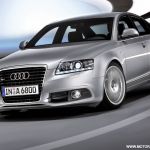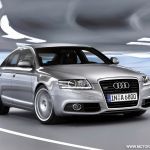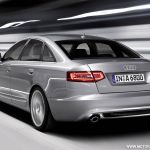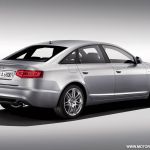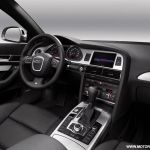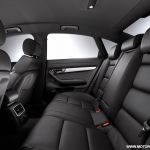2009 Audi A6 Sedan Facelift
Over the past decade, Audi has made huge inroads into the full-size sedan (and station wagon) market in Europe. A lot of buyers have been disappointed with the Bangled styling of the BMW 5-series and left cold by the conservative Mercedes E-class. As a result, the fast lane on the autobahn is all but dominated by corporate Germany’s armada of black, xenon-headlamp-armed Audi A6 sedans and wagons.
One year after a slight face lift of the BMW 5-series and six months before Mercedes launches an all-new E-class at the Geneva auto show, the time is right for Audi to give its A6 a makeover. The most interesting feature is an available supercharged V-6, but before we get there, let’s check out the cosmetics.
The front end gets Audi’s now-trademark LED daytime running lights in the form of slim strips. The huge grille—Audi calls it “single frame” —has a slightly different shape. The most obvious novelties are the gigantic (if only partially functional) air intakes, which dominate the front bumper. Aggressive but somewhat inelegant, these A6 bumpers make the more powerful and sporty S6, which uses a front bumper with LED strips mounted lower, suddenly appear modest and subtle.
While the changes in the front are debatable, the rear styling of the sedan clearly profits from a new trunk lid and wider taillights. A fake diffuser mirrors the front air intakes. The tailgate and taillights on the Avant wagon remain almost unchanged, which is fine with us; the A6 Avant may be the most beautiful station wagon on the market. Four years after its launch in Germany, the A6 still looks crisp, and the changes should give it enough newness to stand its own against the competition.
More Gadgets than Your Favorite Inspector
Inside, the electronics are improved. The A6 features the third-generation MMI interface. The changes are mainly internal; for example, there are now just two control units for the MMI instead of five or more. The graphics are somewhat more sophisticated, if not outstanding. There is a new joystick on top of the controller knob to let you navigate more easily. Audi’s MMI is a complex system, but we’d argue it remains more intuitive than BMW’s iDrive. And while we like touch-screen displays, we greatly prefer this to any touch-screen system that blanks out functions while the car is moving.
We suspect that overly safety-minded customers have clamored for the lane-assist system that makes the steering wheel vibrate excitedly as you are about to veer off the road. In reality, every time you change a lane without using your signal, and every time you dare to cut a corner, you are reminded of your impropriety. The buzz is loud enough for the passenger to notice, too.
There is also a side-assist system, which monitors the driver’s blind spots. If a car is in a blind spot or approaches rapidly from behind, an amber light visible to the driver comes on in the side rearview mirror. In this type of a situation, if you activate a signal with intent to change lanes, the light will begin flashing rapidly. If you don’t use the signal? Well, there is always lane assist to remind you to do so . . .
Can We Interest You In Something With a Supercharger?
In the U.S., Audi will offer four engines in the A6 family: two V-6 engines and a V-8 in the regular car, and one V-10 in the S6, all springing from a similar engine architecture. The entry-level engine remains the 3.1-liter V-6 direct-injection unit—Audi calls the trim level using this engine the “3.2”—rated at 255 horsepower and mated to Audi’s continuously variable transmission. This engine comes paired with front-wheel drive only.
The A6’s top-level engine, a 4.2-liter V-8 rated at 350 horsepower, also carries over unchanged, and so does the 435-hp, 5.2-liter V-10 in the S6. Both come with Quattro all-wheel drive and a six-speed automatic transmission.
Audi’s big news is the intermediate engine: a new 3.0-liter V-6 fitted with a Roots-type supercharger that lives between the cylinder banks. It delivers up to 11.6 psi of boost. The numbers: 300 horsepower from 4850 rpm to the 6800-rpm redline and 310 lb-ft of torque between 2500 and 4850 rpm. Response is instant from idle, with no lag of the sort usually associated with turbocharged engines. This engine delivers torque instantly at any engine speed, superior even to many naturally aspirated engines. There is a throaty exhaust note, but hardly a touch of the whine you experience on other supercharged cars, such as the Jaguar XJ.
Perhaps that’s why Audi hopes to get away with calling this supercharged direct-injection powerplant—very similar to the next S4’s 330-hp engine—a “TFSI” engine, a nomenclature that usually denotes turbocharging. Audi says it doesn’t want to confuse customers, but perhaps Audi’s marketing guys are just underestimating them.
It Will Boogie
The supercharged V-6 offers performance at the upper level of its class. The sprint from 0 to 62 mph takes a claimed 5.9 seconds, while top speed is governed at 155 mph. Both numbers match the 4.2 V-8, which is differently geared. Fuel consumption is reported as 25 mpg in the European cycle.
On the road, this engine is so far superior to the entry-level V-6 and so close in responsiveness and easily attainable speed to the V-8 that it is our engine of choice in the A6. It is, by the way, the only engine available in the Avant station wagon.
Audi starts delivery in the first quarter of 2009. Expect prices to remain similar to the outgoing model, which range from just under $44,000 for a 3.1-liter front-driver to over $57,000 for a V-8–powered Quattro model. The Avant currently rings up at a smidge under $50,000.
In Europe, of course, picking favorites is a different story. The engine lineup is far more extensive, one extreme being marked by a 2.0-liter four-cylinder turbo-diesel that averages more than 44 mpg. The other extreme is the top-of-the-line RS 6, which is powered by what essentially is a twin-turbocharged S6 engine. It is rated at 580 horsepower—far beyond the Mercedes E63 AMG, BMW M5, and Cadillac CTS-V.
At the end of the day, the changes to the A6 would be insignificant if it weren’t for the introduction of the powerful, smooth, and responsive supercharged V-6. Too weak with the 3.1-liter V-6 and extremely expensive with the V-8, the A6 now has a “just-right” engine choice that should help it shrug off its also-ran status in the U.S. market.
